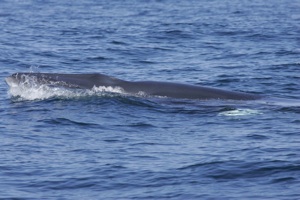Marine Mammal Species Description
Minke Whale
Balaenoptera acutorostrata
Lacépède, 1804

Photo credit: Wayne Hoggard NOAA/NMFS/SEFSC
Classification
Order: Cetacea
Family: Balaenopteridae
Alternate Common Names: Common minke whale, northern minke whale, sharp-headed finner, lesser rorqual, piked whale, little piked whale.
Status: protected under MMPA
Description:
Length: 25-29 ft (7.8-8.8 m); maximum: 35 ft (10.7 m)
Weight: 44,100-88,200 lbs (20,000-40,000 kg)
Common minke whales have a very pointed or triangular upper jaw, and a tall, falcate dorsal fin located on the second half of its body. They have up to 70 ventral grooves or pleats on their throat that extend backward past their flippers. These pleats expand to aid in feeding. These whales are in the suborder Mysticeti, or the baleen whales. Baleen whales do not have teeth, but have plates attached to their upper jaws. These baleen plates are hard, but flexible, which baleen whales use to filter their food from the water. They are dark gray to black on their backs, grayish sides, and white underneath. Minke whales that occur in the northern hemisphere have a white band across each of their flippers.
Habitat:
Common minke whales occur in coastal waters as well as in the deep sea. They are most often seen in coastal areas. They occur singly or in schools of two to three individuals. In the Antarctic, schools may occasionally include hundreds of individuals.
Feeding:
This species eats krill, fish, and aquatic invertebrates.
Reproduction:
In the northern hemisphere, Common minke whales reach sexual maturity around 6-7 years old. In the western Atlantic, the breeding season is from October to March. The gestation period is about 10 months. Females nurse their calves for about 5-6 months.
Other:
Common minke whales are fairly fast swimmers and can reach speeds of up to 21 miles per hour (34 km per hour).
Distribution / Range:
Common minke whales are found in all oceans worldwide, from the ice edge in the polar region to the tropics. In the North Atlantic, common minke whales spend the summer in northern areas in the Arctic, and in the winter they occur as far south as the Caribbean. Along the coasts of North America, some individuals spend fall and winter offshore in southern regions and migrate north in the spring and summer.
Similar species:
Common minke whales are the smallest members of their genus. Their head shape and white on the flippers makes them relatively easy to identify if conditions are good or they are close.
Notes:
References:
American Cetacean Society. 2004. American Cetacean Society Fact Sheet. http://www.acsonline.org/factpack/MinkeWhale.htm. Accessed January 2012.
Jefferson, T.A., S. Leatherwood, and M.A. Webber. 1993. FAO species identification guide. Marine mammals of the world. Rome, FAO. 320 p. 587 figs.
Perrin, W.F. and R.L. Brownell, Jr. 2009. Minke Whales - Balaenoptera acutorostrata and E. bonaerensis. In: Encyclopedia of Marine Mammals 2nd Ed. Perrin W.F., B. Würsig, and J.G.M. Thewissen, eds. Academic Press, New York, pp. 733-735.
Reilly, S.B., Bannister, J.L., Best, P.B., Brown, M., Brownell Jr., R.L., Butterworth, D.S., Clapham, P.J., Cooke, J., Donovan, G.P., Urbán, J. & Zerbini, A.N. 2008. Balaenoptera acutorostrata. In: IUCN 2011. IUCN Red List of Threatened Species. Version 2011.2. www.iucnredlist.org. Downloaded on 09 January 2012.
Stewart, B.S. 1999. Minke whale, Balaenoptera acutorostrata. In The Smithsonian Book of North American Mammals. Wilson, D.E. and S. Ruff, eds., 246-248. Smithsonian Institution in association with the American Society of Mammologists, Washington DC.

 Marine Mammals of Georgia
Marine Mammals of Georgia